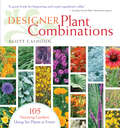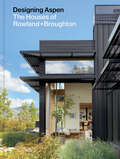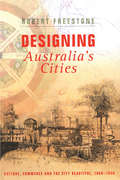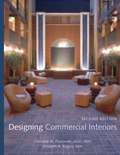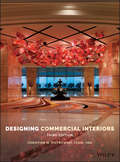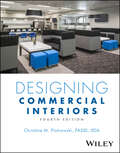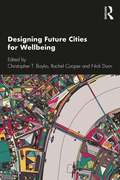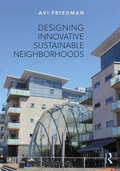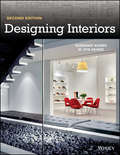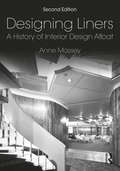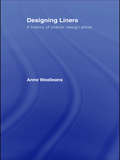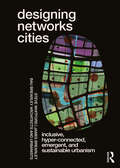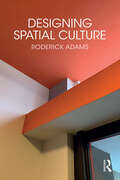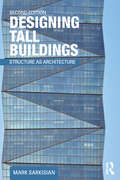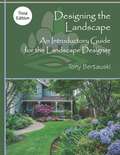- Table View
- List View
Designer Knit Home: 24 Room-By-Room Coordinated Knits to Create a Look You'll Love to Live In
by Erin Eileen BlackSurround yourself with beautiful knits in every room in your house! Patterns are styled and grouped by room to create a unified look for your Living Room, Porch, Master Bedroom, Guest Bedroom, Office, Kid's Bedroom, and Nursery. All pieces are knit with big needles and easy-to-learn stitch patterns, so you can be enjoying your knits in no time. Every room has at least one textured chunky blanket for comfort; other patterns include cushion covers, pillows, baskets and others, all in coordinating stitch/style and colors. The sumptuous knits are shown styled in a modern, neutral palette that works well in any decor, but if your style is more colorful, the patterns are classics that will work in any color scheme you choose.
Designer Plant Combinations: 105 Stunning Gardens Using Six Plants or Fewer
by Scott CalhounTurn your backyard garden into a lush and colorful wonderland where every plant is presented to its fullest potential. Scott Calhoun provides more than 100 stunning garden designs that are adaptable to a range of climates, budgets, and space considerations. As you learn to use proven groupings and discover ways to make your garden glow throughout all seasons, you’re sure to find the right combination of flowers, grasses, and ground coverings to transform your property into a jaw-dropping display of color, texture, and fragrance.
Designing Accessibility Instruments: Lessons on Their Usability for Integrated Land Use and Transport Planning Practices
by Luca Bertolini Cecilia Silva Nuno PintoThe integration of land use and transport planning is key to making cities sustainable and liveable. Accessibility can provide an effective framework for this integration. However, today there is a significant gap between the advances in scientific knowledge on accessibility and its effective application in planning practice. In order to close this gap, Designing Accessibility Instruments introduces a novel methodology for the joint assessment and development of accessibility instruments by researchers and practitioners. The book: provides a theoretical and professional analysis of the main concepts behind the definition, use and measurement of accessibility; undertakes a comprehensive inventory and critical analysis of accessibility instruments, focusing on the bottlenecks in their transposition to planning practice; introduces and applies a novel methodology for the assessment and improvement of the practical use and usefulness of accessibility instruments; presents six in-depth illustrative case study applications of the methodology, representing a range of cities with different geographical and institutional settings, and different levels of urban and transport planning integration. The book is supported by a companion website – www.accessibilityplanning.eu – which extrapolates its content to a broader scope and keeps it updated and valid with new iterations of the methodology and further advances on the initial and new case studies.
Designing Aspen: The Houses of Rowland+Broughton
by John Rowland Sarah BroughtonIn this luxurious and aspirational home design book, the founders of renowned Colorado firm Rowland+Broughton share a selection of their extraordinary residential projects, with Aspen and the Rocky Mountains as the dazzling backdrop.Rowland+Broughton is known for shaping the town of Aspen with their visionary work in urban design and historic preservation. Here, founders John Rowland and Sarah Broughton showcase ten spectacular residences in Aspen and the Rocky Mountains created by their innovative and talented firm.With beautiful photography throughout, Designing Aspen includes a range of houses, from Mountain Retreat, a modern lodge-style home located at the base of Aspen Highlands, to Meadow House, positioned at the edge of a meadow amid an existing forest of spruce and evergreens, and from Art Barn, a residence with the specific purpose of displaying art, to Bagua, a Zen mountain retreat. Also featured are essays about Aspen and its history and relevance; the importance of historic preservation; client relationships; and the philosophy of the firm; and a foreword by Tom Kundig. Perfect for lovers of home design and architecture, anyone who aspires to build or decorate a house in the mountains, and visitors and residents of Aspen enthralled by its charms, this makes a beautiful coffee table book and a captivating volume of residential design expertise and inspiration.
Designing Australia's Cities: Culture, Commerce and the City Beautiful, 1900�1930 (Planning, History And Environment Ser.)
by Robert FreestoneAccessible and comprehensive, written by the current President of the International Planning History Society, this volume provides readers with a highly visual account of historical, contemporary and international projects.Looking at the ways in which the City Beautiful movement influenced the design and development of Australian cities, this pioneering national study surveys the ruling ideas, influences, outcomes and enduring legacies of the early artistic turn in Australian urban design. With the return of the American City Beautiful movement to the forefront of urban design, Designing Australia’s Cities is a relevant account of the ways in which this movement influenced and shaped Australian city design, but more importantly sheds light on a planning culture that stretches far beyond Australia and is of increasing relevance worldwide today.Laying bare an important design and reform movement, whose under-appreciated legacy is clearly evident in urban landscapes today, this book is ideal for students of planning, architecture, urban design and the history of planning.
Designing Coffee Shops and Cafés for Community
by Lisa K. WaxmanDesigning Coffee Shops and Cafés for Community brings together research, theory, and practical applications for designing coffee shops and cafes as places to enhance community connections. As people search for meaning and connection in their lives, they often seek out places that root them in their community. Designers are responsible for creating these spaces, and to do so well, they need to understand the physical and social attributes that make such spaces successful. Addressing societal trends, environment and behavior theories, place attachment, branding, authenticity, location, layout, and ambiance, the book provides guidelines to help designers and operators create more welcoming third places—places that are not home, not work, but those where we can relax in the company of others. It includes eight case studies by authors from threecountries that ground the theories in real-life third places. Its practical design guidelines cover location, accessibility, seating, lighting, sound, and more. Written for students, academics, and designers, this book discusses the value of coffee shops and cafés and guides readers through the ways to create places of belonging that bring people together.
Designing Commercial Interiors
by Christine M. Piotrowski Elizabeth A. Rogers IIDAThe definitive reference on designing commercial interiors-expanded and updated for today's facilitiesFollowing the success of the ASID/Polsky Prize Honorable Mention in 1999, authors Christine Piotrowski and Elizabeth Rogers have extensively revised this guide to planning and designing commercial interiors to help professionals and design students successfully address today's trends and project requirements. This comprehensive reference covers the practical and aesthetic issues that distinguish commercial interiors. There is new information on sustainable design, security, and accessibility-three areas of increased emphasis in modern interiors.An introductory chapter provides an overview of commercial interior design and the challenges and rewards of working in the field, and stresses the importance of understanding the basic purpose and functions of the client's business as a prerequisite to designing interiors. This guide also gives the reader a head start with eight self-contained chapters that provide comprehensive coverage of interior design for specific types of commercial facilities, ranging from offices to food and beverage facilities, and from retail stores to health care facilities. Each chapter is complete with a historical overview, types of facilities, planning and interior design elements, design applications, a summary, references, and Web sites. New design applications covered include spas in hotels, bed and breakfast inns, coffee shops, gift stores and salons, courthouses and courtrooms, and golf clubhouses.In keeping with the times, there are new chapters focusing on senior living facilities and on restoration and adaptive use. A chapter on project management has been revised and includes everything from proposals and contracts to scheduling and documentation. Throughout the book, design application discussions, illustrations, and photographs help both professionals and students solve problems and envision and implement distinctive designs for commercial interiors.With information on licensing, codes, and regulations, along with more than 150 photographs and illustrations, this combined resource and instant reference is a must-have for commercial interior design professionals, students, and those studying for the NCIDQ licensing exam.Companion Web site: www.wiley.com/go/commercialinteriors
Designing Commercial Interiors
by Christine M. PiotrowskiA practical, comprehensive resource for commercial interior design Designing Commercial Interiors is the industry standard reference, now fully revised and expanded to reflect the latest developments in commercial interior design. This book guides you through the entire design process, from planning to execution, to teach you the vital considerations that will make your project a success. This new third edition includes new: Sustainability concepts for a variety of commercial spaces Coverage of accessibility, security, safety, and codes--and how these factors influence commercial design Chapters on design research, project process, and project management Drawings and photographs of design applications Supplemental instructor's resources Commercial interior design entails a much more complex set of design factors than residential design, and many of these considerations are matters of safety and law. This book walks you through the process to give you a solid understanding of the myriad factors in play throughout any commercial project, including how the global marketplace shapes designers' business activities. Whether it's a restaurant, office, lodging, retail, healthcare, or other facility, the interior designer's job is much more complicated when the project is commercial. Designing Commercial Interiors is an exhaustive collection of commercial design skills, methods, and critical factors for professionals, instructors, and those preparing for the NCIDQ exam.
Designing Commercial Interiors
by Christine M. PiotrowskiPractical, comprehensive resource for commercial interior design, covering research, execution, safety, sustainability, and legal considerations Designing Commercial Interiors explores the entire design process of commercial projects from planning to execution to teach the vital considerations that will make each project a success. This book delivers a solid understanding of the myriad factors in play throughout designing restaurants, offices, lodging, retail and healthcare facilities. Updates to the newly revised Fourth Edition include changes to office space design to promote flexibility, post-pandemic considerations for work and interior design, the latest industry certification requirements, sustainable design considerations. and safety/legal codes. Updated supplemental instructor’s resources, including a revised instructor’s manual with sample test questions and exercises are available on the companion website. A list of terms fundamental to each chapter has also been added at the end of each chapter. Other topics covered in Designing Commercial Interiors include: A thorough review of relevant design and research skills and methods How the global marketplace shapes designers’ business activities Product specification principles, WELL, and LEED certification and credentials Accessible design in facilities, elements of evidence-based design, and adaptive reuse Project manager responsibilities, working with stakeholders, and special considerations for executive-level clients Project delivery methods, including design-bid-build, design-build, and integrated design Designing Commercial Interiors is an authoritative and complete reference on the subject for university and community college students in programs related to interior design and those preparing for the NCIDQ exam. The text is also valuable as a general reference for interior designers less familiar with commercial interior design.
Designing Future Cities for Wellbeing
by Christopher T. BoykoDesigning Future Cities for Wellbeing draws on original research that brings together dimensions of cities we know have a bearing on our health and wellbeing – including transportation, housing, energy, and foodways – and illustrates the role of design in delivering cities in the future that can enhance our health and wellbeing. It aims to demonstrate that cities are a complex interplay of these various dimensions that both shape and are shaped by existing and emerging city structures, governance, design, and planning. Explaining how to consider these interconnecting dimensions in the way in which professionals and citizens think about and design the city for future generations’ health and wellbeing, therefore, is key. The chapters draw on UK case and research examples and make comparison to international cities and examples. This book will be of great interest to researchers and students in planning, public policy, public health, and design.
Designing Gardens with Flora of the American East, Revised and Expanded
by Carolyn Summers Kate BrittenhamAs recent years have seen alarming declines of insect and bird populations in many states, more gardeners have discovered the importance of including native plants in order to nurture these pollinators and sustain local ecosystems. But when so many popular landscaping designs involve exotic cultivars and invasive plant species, how can you create a garden that is both aesthetically pleasing and ecologically responsible? In this fully revised second edition of the classic guide Designing Gardens with Flora of the American East, gardening expert Carolyn Summers draws on the most recent research on sustainable landscaping. She is joined in this edition by her daughter, landscape designer Kate Brittenham, offering an intergenerational dialogue about the importance of using indigenous plants that preserve insect and bird habitats. The practical information they provide is equally useful for home gardeners and professionals, including detailed descriptions of keystone trees, shrubs, perennials, vines, and grasses that are native to the eastern United States. Accompanied by entirely new illustrations and updated plant lists, they offer chic yet eco-friendly landscape designs fully customized for different settings, from suburban yards to corporate office parks. The states covered in this book are CT, DE, IA, IL, IN, KY, MA, MD, ME, MI, MN, MO, NC, NH, NJ, NY, OH, PA, RI, TN, VA, VT, WI, and WV, as well as southern Quebec and Ontario.
Designing Innovative Sustainable Neighborhoods
by Avi FriedmanThis book covers fundamental aspects of neighborhood planning and architecture along sustainable principles. Written by a designer and instructor, the book’s fully illustrated chapters provide detailed insights into contemporary strategies that architects, planners and builders are integrating into their thought processes and residential design practices. Past approaches to planning and design modes of dwellings and neighborhoods can no longer sustain new demands and require innovative thinking. This book explores new outlooks on neighborhood design, which are propelled by fundamental changes that touch upon environmental, economic and social aspects. It presents contemporary well-designed and illustrated examples of communities and detailed analysis of topics including the depletion of non-renewable natural resources, elevated levels of greenhouse gas emissions and climate change. It also explores the increasing costs of material, labor, land and infrastructure, which pose economic challenges; as well as social challenges including the need for walkable communities and the increase in live-work environments. The need to think innovatively about neighborhoods is at the core of this book, which will be useful to students and practitioners of urban design, urban planning, geography and urban systems; and to architecture studios focused on sustainable residential development.
Designing Interiors
by W. Otie Kilmer Rosemary KilmerAfter its publication in 1992, Designing Interiors became a hugely successful reference tool and designing textbook. In Designing Interiors, Second Edition, updates on trends in sustainability and green design, building codes, universal design, and building information models amplify the already invaluable interior design tricks of trade. Design professors Rosemary and Otie Kilmer provide a fuller design history that incorporates non-Western design and dynamic color illustrations that flesh out technical concepts.
Designing Interiors
by W. Otie Kilmer Rosemary KilmerThe latest edition of the groundbreaking introduction to interior design Designing Interiors serves as a comprehensive overview of the basic knowledge required to become a professional interior designer. As the field of interior design evolves, education and practice continue to emphasize solid expertise in designing for people, their environments, and a better quality of life for all. This revised and updated Third Edition ushers in a new era of design for a new generation of interior designer students, with vital information on post pandemic design trends, additional coverage of sustainability, and key issues related to building codes. Design professors Rosemary and Otie Kilmer provide a complete design history that incorporates non-Western design and dynamic color illustrations that flesh out technical concepts. This third edition of Designing Interiors also includes: Space planning residential spaces post-pandemic Expanded sustainability guidance including Green Certification programs; WELL, FITWEL, Energy Star, and more Updated supplemental instructor resources and activitiesNew interior photographs illustrating today’s interior design projects Up to date information on “Interior Design as a Profession” post pandemic Intended primarily as an introduction to interior design at the college level, Designing Interiors, Third Edition can also be used in subsequent studio courses, and is an ideal resource for working professionals.
Designing Landscape Architectural Education: Studio Ecologies for Unpredictable Futures
by Rosalea Monacella and Bridget KeaneNo single project or endeavour is immune to the issues that the climate crisis brings. The climate crisis encompasses a broad register of "symptoms" – increased global temperatures and sea-level rise, droughts and extreme bushfire events, salinification and desertification of fertile land, and the list goes on. It reveals and amplifies complex causal relationships that are inherently present and traverse scales, sectors and communities divulging a range of impacts and inequalities. This publication asks designers and academic practitioners to describe their own work through an ecological lens, and then to articulate design approaches for developing new practices in landscape architecture teaching. Designing Landscape Architectural Education: Studio Ecologies for Unpredictable Futures, the Landscape Architecture Design Studio Companion, serves as a resource for academic practitioners in the preparation and delivery of "design-research studios" and students seeking guidance for design methodologies as a part of their landscape architectural education. It draws on the manifold issues of the climate crisis as a set of drivers to examine the utilisation of a range of innovative design approaches to address the current and future priorities of the discipline. The landscape architecture discipline is evolving rapidly to respond to both a broadening and intensification of changes in the environmental, social and political conditions. These changing conditions require innovation that extend the core competencies of landscape architects. This book addresses two fundamental questions – what are the design competencies required of landscape architects to equip them to deal with the complexities brought forth by contemporary society, and as a result, how could we design the future design studio?
Designing Liners: A History of Interior Design Afloat
by Anne MasseyDesigning Liners: A History of Interior Design Afloat covers the interior design of these floating palaces from the mid-nineteenth century to the twenty-first century. In this new edition, the design heritage of the ocean liner is also explored in this age of a growing holiday cruise market. The book offers the first history and analysis of this highly significant aspect of the design of interiors, which mirrors and reinforces cultural assumptions about national identity, gender, class and ethnicity. The interiors of ocean liners reflect the changing hierarchies of society and shifting patterns of globalization. The trajectory of the professionalization of interior design is the connecting narrative of the book, from the local decorating firm to the internationally renowned architect. It is an important addition to interior design research and takes this transitory building type as its subject. This book provides the first survey of the transient history of interior design in relation to the development of passenger shipping. The history of these great ship interiors is tracked, from their commissioning by the line owners; the materials, methods and sources for the initial creation; their construction; their use and reception. The demise and re-purposing of the interiors is also covered in this new edition, with additional material on the South African Union Castle and P & O lines. Drawing on a broad range of original research, Anne Massey’s approach combines interior design studies, design history, architectural history and maritime studies. The new edition has been carefully designed to include black and white and colour illustrations.
Designing Liners: A History of Interior Design Afloat
by Anne WealleansThis in-depth history of the interior design of ocean liners surveys the transient history of interior design in relation to the development of passenger shipping, from commissioning by the line owners, methods and sources for the original creation of designs through to its construction, use and influence. It is a short-lived branch of architecture and design, lasting an average of fifteen years. As the design and taste mirrors and reinforces cultural assumptions about national identity, gender, class and race, not only did the interiors of ocean going liners reflect the changing hierarchies of society and shifting patterns in globalization, but the glamour and styling of the liners were reflected back into the design of interiors on land. Combining design history, architecture history, material and visual cultures, Designing Liners is a richly multidisciplinary work for those studying or researching this application of interior design.
Designing Networks Cities: Inclusive, Hyper-Connected, Emergent, and Sustainable Urbanism
by Steve Whitford James Brearleydesigning networks cities presents a sophisticated, multi-disciplinary, and multi-dimensional approach to urban design. Emerging from years of practice, experimentation, and research by designers (landscape architects, urban planners, urban designers and architects), this approach engages with contemporary thought across a number of disciplines to re-invent the entrenched blunt instruments of the city making process. A cry for flexible, sharp-instruments in urban design, designing networks cities presents a multi-dimensional way of seeing the essential components of the city (form, space-time, order and aesthetics). It purposefully links traditional architectural design derivation mechanisms to urban design, in the hope that cities will not only be pragmatic, but also become sophisticated iconographically, poetically, and syntactically. It provides the tools to enable decision making within a multiplicity of constraints and opportunities: a philosophy of becoming, not being; a science of dynamic systems, not stasis; and an art of sensations, not subjectivity. And finally, and most importantly, it argues why it is important that cities embrace these multiple dimensions of society on a planet that is facing increasing environmental challenges: an economics focused on equity for all, not for some more than others; a politics supporting a genuine representational democracy, not one representing the overly influential; and a culture [including history] that embraces difference, not one that encourages division. designing networks cities not only provides the means to identify these issues and a methodology to deal with them within a complex emerging co-existence, but also demonstrates the development of cities that embrace and respond to the complexities of life in what some are calling the Anthropocene.
Designing Rainwater Harvesting Systems
by Kathy M. Debusk Eddie Van Giesen Celeste Allen NovakWater conservation is one of the most effective sustainable design practices, yet few professionals know how to collect and use rainwater effectively. Rainwater Harvesting the first comprehensive book on designing rainwater harvesting systems. It provides practical guidelines for developing a rainwater harvesting strategy, taking into account climate, public policies, environmental impact, and end uses. Case studies are included throughout. Rainwater Harvesting is a valuable reference for architects, landscape architects, and site engineers.
Designing Spatial Culture
by Roderick AdamsDesigning Spatial Culture investigates a powerful experiential dialogue formed between the habitation of space and a diversified cultural realm. This creative proposition binds and positions human activity and experience framing its histories, currency and future. Whilst the book distinguishes between the conditions of the existing urban/ architecture/ interior canon, it embraces a new agency of space, showcasing the encounters, assemblies and designs that shape human behaviours and the cultural forms of the built environment. Using authoritative case studies, the book examines many locations and spaces, ranging from new urban landscapes, historical domestic spaces and contemporary architecture. It embraces the most lavish and flamboyant to the most simplistic and minimal, establishing a connected cultural narrative. The book shifts the focus in the spatial realm from an object-based experience (where space is filled with things) to a more complete immersive experience (combining physical and digital). A key part of this exploration is the relationship between the architecture and the interior which is often the most predominant spatial experience and fundamental to the understanding spatial experience and existing cultures. Without the architectural enclosure, the interior would lose its site context and structure for its existence. Without an interior, architecture would not fully develop an engaging spatial experience for the user. The book rationalises this through extended use of a spatial probe which documents and summarises an evidence-based research project capturing spatial culture data from a predominantly domestic setting. The book is essential reading for students and researchers in architecture, interior design and urban design.
Designing Sustainable Factories: A Toolkit for the Assessment and Mitigation of Impact on the Landscape (Advances in Global Change Research #72)
by Lia MarchiEconomic constraints and lack of knowledge often prevent companies - especially small and medium enterprises - from harmonizing their facilities with the landscape. As a result, factories significantly impact the quality of our living environment, in terms of physical effects on the ecosystem, perceptual interferences with the surroundings, and disturbances on local communities. At both the design and maintenance stages, a set of appropriate tools can assist businesses in becoming more aware of their impacts and identifying possible mitigation strategies. The book presents an assessment tool and a library of inspiring design tactics for factories, with examples of the benefits and synergies for the environment, the scenery, the community, and the company itself. The purpose is to elicit more than a simple reflection about what a sustainable factory entails. It is rather to encourage and assist both businesses and designers in mitigating the impact of industrial facilities on the landscape as holistically as possible.
Designing Sustainable Forest Landscapes
by Simon Bell Dean ApostolDesigning Sustainable Forest Landscapes is a definitive guide to the design and management of forest landscapes, covering the theory and principles of forest design as well as providing practical guidance on methods and tools. Including a variety of international case studies the book focuses on ecosystem regeneration, the management of natural forests and the management of plantation forests. Using visualisation techniques, design processes and evaluation techniques it looks at promoting landscapes which are designed to optimise the balance between human intervention and natural evolution. A comprehensive, practical and accessible book, Designing Sustainable Forest Landscapes is essential reading for all those involved in forestry and landscape professions.
Designing Tall Buildings: Structure as Architecture
by Mark SarkisianThis second edition of Designing Tall Buildings, an accessible reference to guide you through the fundamental principles of designing high-rises, features two new chapters, additional sections, 400 images, project examples, and updated US and international codes. Each chapter focuses on a theme central to tall-building design, giving a comprehensive overview of the related architecture and structural engineering concepts. Author Mark Sarkisian, PE, SE, LEED® AP BD+C, provides clear definitions of technical terms and introduces important equations, gradually developing your knowledge. Projects drawn from SOM’s vast portfolio of built high-rises, many of which Sarkisian engineered, demonstrate these concepts. This book advises you to consider the influence of a particular site's geology, wind conditions, and seismicity. Using this contextual knowledge and analysis, you can determine what types of structural solutions are best suited for a tower on that site. You can then conceptualize and devise efficient structural systems that are not only safe, but also constructible and economical. Sarkisian also addresses the influence of nature in design, urging you to integrate structure and architecture for buildings of superior performance, sustainability, and aesthetic excellence.
Designing The Landscape: An Introductory Guide For The Landscape Designer
by Tony BertauskiEvery professional landscape designer develops his or her own design process, emphasizing some steps while minimizing or eliminating others. It's important to learn every aspect of the process before getting on the job. Bertauski's comprehensive and readable Designing the Landscape presents every facet of the design experience from client interviews and concepts through presenting and pricing a master plan, so students can learn what works and what doesn't when they still have the time and opportunity to make valuable mistakes. The author's focus on topics that foster understanding of the functionality and aesthetics of design equips students with skills they need to be effective designers. While residential design is emphasized, many concepts and steps can be applied to commercial projects. Also available from Waveland Press by Tony Bertauski, Plan Graphics for the Landscape Designer with Section-Elevation and Computer Graphics, Third Edition (ISBN 9781478637264).
Designing Therapeutic Environments: Social and Cultural Practice for Health and Well-Being
by Bruno Marques Jacqueline McIntoshThis book draws on the relationship between culture and the environment and its connection with health and well-being. Therapeutic environments are settings that comprise the physical, ecological, psychological, spiritual and social environments associated with treatment and healing. Throughout the chapters, the understanding of therapeutic environments is broadened through the exploration of specific Indigenous cultural and social dimensions. Case studies comprise a combination of research papers regarding the theoretical and conceptual underpinnings of therapeutic environments and their application following traditional methods. This book contributes to the expanding body of knowledge focusing on the role of therapeutic environments and their role in shaping health and well-being through the development of new research methods.This book is essential for practitioners, scholars and students in architecture, landscape architecture, interior architecture, urban design, planning, geography, building science, public health and environmental engineering.

